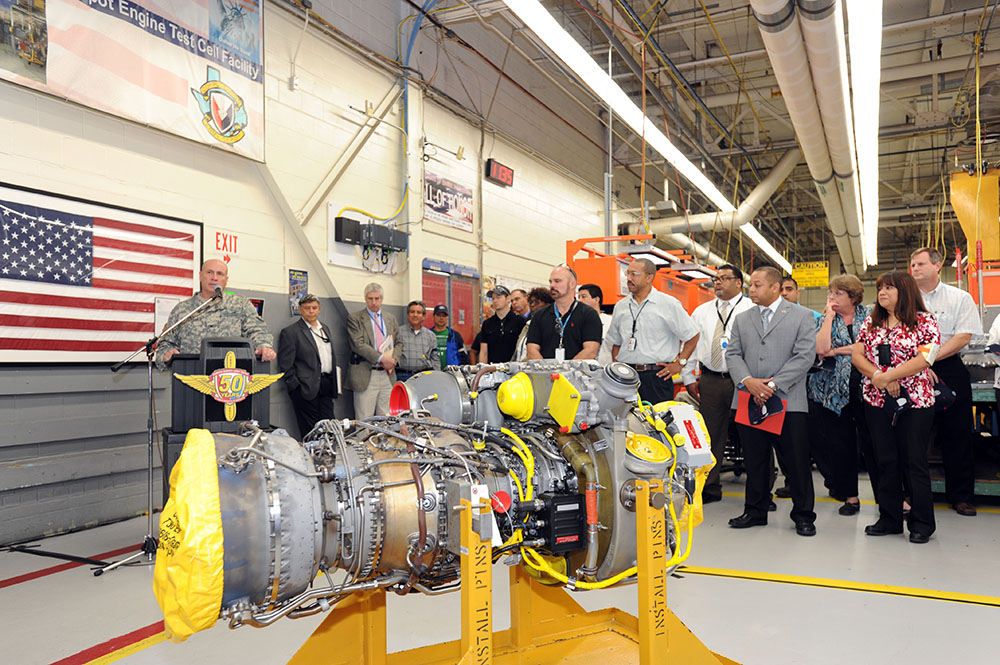
By Jaclyn Nix, CCAD Public Affairs
Corpus Christ Army Depot with partner, General Electric, celebrated the completion of the 3,000th T701D conversion engine overhaul with a small cake cutting ceremony in the Engine Test Cell area on February 23, 2012.
The U.S. Army plans to convert its entire fleet of UH-60M Black Hawk and AH-64 Apache helicopters to the T701D engine. At 2,000 shaft horsepower, the T701D features improved hot-section components that provide twice the hot-section durability and five percent more power than the current T700-GE-701C model engine.
“These engines support the most advanced fighting force the world has ever seen,” said Roderick Benson, Director of Engine Production.
CCAD completely rebuilds and upgrades these engines to like-new condition but with better performance and durability. There are three separate kits associated with these conversions. Each kit contains approximately 285 parts, totaling up to 855,000 parts for the 3,000 engines handled and installed for the upgrade.

Tony Conrad, General Electric Site Manager; Col. Christopher Carlile, CCAD Commander; Brandy Gonzales, T-700 Division Chief; and Rod Benson, Director of Engine Production cut the cake Air Assault style with the depot’s saber during the ceremony. (U.S. Army Photo by Ervey Martinez).
The engine process is tedious much like anything done at CCAD. It is first inducted into pre-shop analysis, disassembled and cleaned before the parts are sent to the prime shops. There, the parts are evaluated for repair, cleaned and disassembled further, depending on the part. The parts are then repaired, routed back to the assembly shop, reassembled into a whole engine, tested and packaged for its final sale. This process takes approximately 100 days or less.
“The partnership has reduced the average time needed to turn around engine projects from 261 days to 78 days, and the amount of time an engine stays in-use has increased 18 percent,” said Tony Conrad, General Electric Site Manager.
The 701D represents an affordable approach to increasing the performance durability of these proven engines. Since CCAD inducted its first 701D conversion in July 2005, the Army has saved approximately $6 million by upgrading engines at CCAD versus purchasing them new.
“Our profit is reducing cost,” said Col. Christopher Carlile, CCAD Commander. “That money we save goes back to the taxpayers.”
The CCAD Commander congratulated General Electric and the CCAD artisans who made this accomplishment possible. He passed out Commander Coins to key personnel involved in this milestone.

Col. Christopher Carlile, CCAD Commander describes the impact the T701D engine (pictured) has on the Warfighter to a crowd of artisans. (U.S. Army Photo by Ervey Martinez).
“Without everyone working together as a team we wouldn’t have been as successful producing the 3,000th conversion engine,” said Brandy Gonzales, T700 Engine Division Chief. “It’s very important that we all work together so that we can produce a quality product at a cost that works for the customer.”
“The people here in this organization all throughout CCAD put their best foot forward each and every day,” said Benson. “It’s the people on the floor that make it happen.”
General Electric (GE) began its relationship with CCAD in 2000 with a Technical, Engineering and Logistical Services and Supplies (TELSS) contract for the T700 family of engines, modules and components.
“We have learned a lot from GE but they have also learned a lot from CCAD,” said Pete Barrientes, Production Tech Analyst.
“As we transition on, we will find new ways to continue to contribute to support the Sailors, Airmen, Soldiers and Marines that depend on us to do so,” said Benson.
In celebration of the 25th anniversary of the Army Acquisition Corps (AAC), Access is publishing articles that highlight milestones throughout the history of the AAC. Each article marks a moment in acquisition excellence.
This article was published on Army.mil, February 27, 2012.







